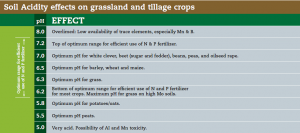FREQUENTLY ASKED QUESTIONS
The following are answers to some of the most commonly asked questions in relation to lime and managing soils that have been recently limed.
More information is available in the Publications and Articles in the Library section of this website.
This section of our website will be updated to reflect questions that we receive. If you have a question for us please submit your query to us in our contact us page.
Calcium limestone is the most common form of ground limestone available. Where dolomitic (Magnesium / Mg) limestone is used as a liming material, it is important that it is not used repeatedly without monitoring the soil Mg levels. The release of such Mg can be very slow, and frequent use of dolomitic limestone can cause soil Mg to rise to very high levels where it can impede the availability and uptake of other nutrients such as K.
A recent soil report will show the rate of lime required depending on the soil type, soil pH and crop type. However a soil analysis result is only as good as the sample taken. A sample normally comprises around 1kg of soil which is taken to represent an entire area or field which contains around 1,000t of soil per hectare to a plough depth of 4″ (10cms). It is therefore imperative to obtain as representative a sample as possible or the results will not reflect the nutrient status accurately.
The lime requirement is calculated in the laboratory based on a test that measures the soils buffering capacity. The buffering capacity is a measure of how much lime it takes to change the pH of the soil to the target pH.
Lime contains calcium and magnesium both of which are alkaline. The calcium and magnesium ions replace acidic hydrogen and aluminium ions through cation exchange. The full effects of lime may take two years to have an effect on soil pH.
Apply lime on “a little and often basis” and improve soil pH in stages over time. Do not exceed 5t/ha in a single application or apply split applications (2.5t/ ha) over several years.
Applied lime can increase the loss of N to the air after slurry application.
If slurry is first applied, leave 1 week before spreading lime. If lime has been applied, avoid slurry application for three months.
The N in urea and cattle slurry are in the same form. Treat urea the same as cattle slurry as described in the previous question.
There is no need to leave a gap with CAN or N P K compounds.
In grassland soils that are high in molybdenum (Mo), it is recommended to maintain the soil pH at or below 6.2. Increasing the soil pH above 6.2 increases the availability of Mo which reduces the availability of Cu in bovines (cattle).
Where there is either a history or risk of soils or herbage being high in Mo, it is recommended to reduce the lime application by 5t/ha. However this is a crude estimation and can be tailored for each situation depending on previous experience.
Problems with high Mo tend to be more common on wetter soils (or in wetter years) in swards with low ryegrass and/or high clover content and where annual rates of nitrogen fertiliser application is low.
Yes, recently limed tillage soils are more prone to Mn deficiency.
To reduce the potential for Mn deficiencies, ensure lime is well incorporated during soil cultivations and seedbeds are well consolidated after sowing.
Generally, lime can be applied at any time of the year, provided the grass sward is low to avoid excess lime sticking to herbage. it is preferable to avoid grazing or cutting until sufficient rainfall has occurred to wash the lime off the herbage.
For silage it is better to apply lime before mid March for first cut or within one week after cutting on land which is being closed for a second cut as the presence of lime on the grass can increase the pH in the silage pit which affects silage preservation. Applying lime to heavy covers of grass intended for silage can reduce silage quality if the lime is not washed off the grass by rain.
Yes, see the table below for guidance. Aim to maintain soil pH close to the target level and apply lime as recommended on the soil test report.
The lime requirement is calculated in the laboratory based on a test that measures the buffering capacity of the soil. Buffering capacity is a measure of how much lime it takes to change the soil pH. Therefore soils that are returned with the same soil pH may be shown to have different lime requirements This is because the soils have different buffering capacities and require more or less lime to achieve the same increase in pH.
Soils that are heavier textured or have higher organic matter contents tend to have higher buffering capacities and higher lime requirements as a result. However while these soils may require more lime following the soil test, the higher buffering capacity should result in the soil retaining lime better in the future once it has been applied.

All lime marketed in Ireland must meet the requirements of S.I 248/78 – “Marketing of non-EEC Fertilisers Regulations 1978” and this is enforced by the Department of Agriculture, Food and the Marine who issue a licence to all approved operators.
Specific requirements contained in SI 248/78 are as follows:
Product must have a Total Neutralising Value (TNV) of not less than 90%
All the product must pass through a 3.35 mm sieve.
Not less than 35% of the product must pass through a 0.15 mm sieve
The moisture content of the product must be less than 3.0%
